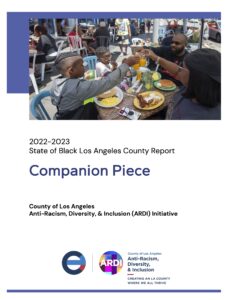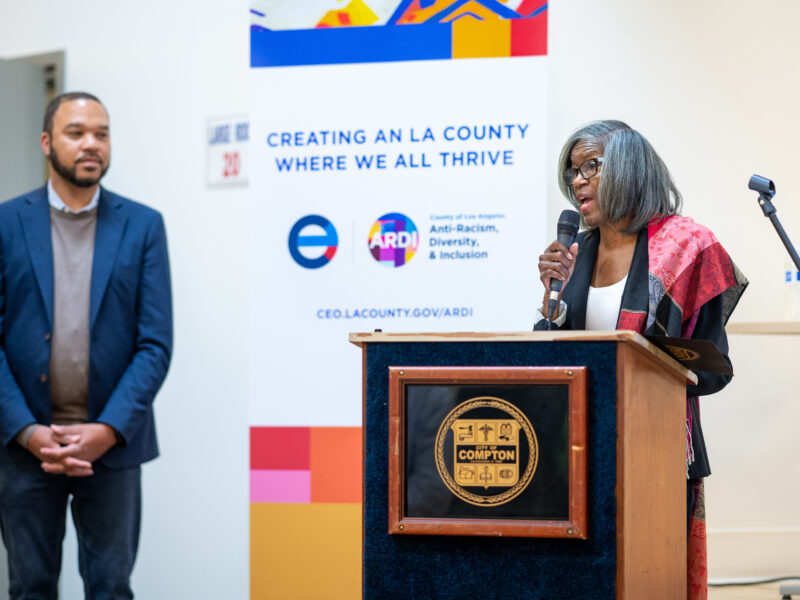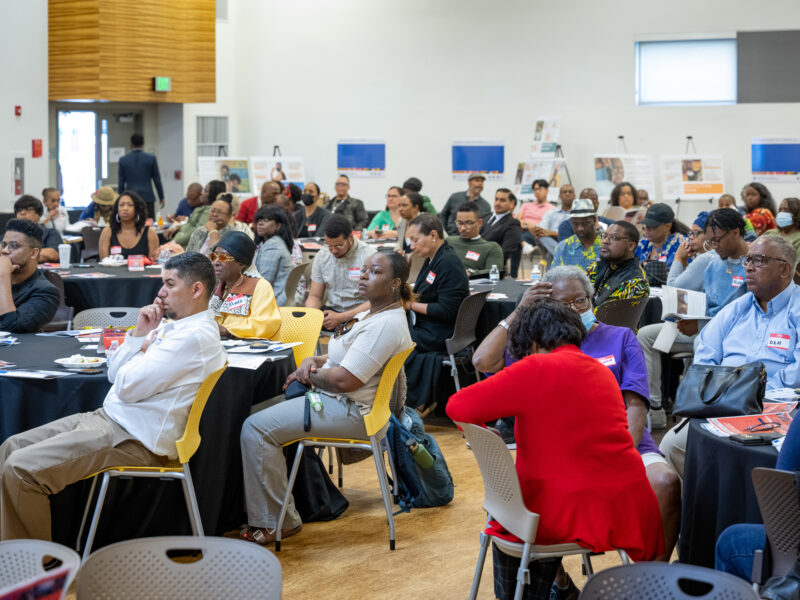State of Black Los Angeles County Report
Los Angeles County is home to the third largest Black population (936,285) in the United States. Since their arrival, Black Angelenos have been integral to the cultural, economic, and sociopolitical landscape of Los Angeles. Yet, despite the many contributions made by Black Angelenos, many continue to experience adverse life outcomes resulting from structural, and specifically anti-Black, racism — including disproportionate rates of homelessness, incarceration, and other outcomes that have a significant impact on overall health and well-being.
The State of Black Los Angeles County Report, is an online interactive report comprised of several in-depth sections centered on the outcomes and lived experiences of Black people in Los Angeles County across a host of metrics. In this report, we assess how Black residents are doing on 36 indicators, all within the domains of health, housing, income and employment, education, and safety and justice.
The report features a series of bar charts, dashboards, and interactive maps enabling users to see racial disparities in outcomes across several indicators and visualize the geographical areas in the County with the most challenging outcomes and/or highest need. It also outlines some of the drivers and root causes of these outcomes as explained by local experts in the field and our review of the peer-reviewed literature in each topic area. For select indicators, we include infographics ranking the highest need communities within each Supervisorial District.
We also highlight 20 geographical areas, providing insight into the history and sociopolitical context of the area, as well as historical and contemporary landmarks that hold unique cultural, historical, or political significance for Black Los Angeles County residents.


Companion Piece
In this companion piece to the full State of Black Los Angeles County Report, we (1) outline the key objectives of the report, (2) explain why this report is necessary, (3) present report highlights and key findings, and (4) provide guidance on how to navigate the report. Click the button below to view the companion piece or continue scrolling to learn more and view the full report.
DIGITAL STORYTELLING
To enhance the user experience of reading this comprehensive report, we chose a web-based application called ArcGIS StoryMaps, which allows users to explore maps alongside narrative text and other multimedia content. As a result, this online report also serves as a multifaceted tool that allows stakeholders—including residents, community advocates, and service providers—to visualize the geographical areas where Black residents are most impacted and by which challenges.
HOW TO NAVIGATE THE REPORT
While each section of the report is comprehensive enough to stand alone, users are encouraged to start at the Introduction section where we define the social and geographical context of Black Los Angeles County, address within-group diversity in the community, and define the concept of anti-Blackness. In the next section, Community Input, we outline the process, as well as the community stakeholders who helped to shape this report. The next section, Research Framework, Data Collection, and Analysis, provides a detailed description of our research approach and methodology, as well as the research framework developed by the research team to assess health and well-being.
The Report Highlights and Key Findings section provides an overview of the report’s findings, including a data dashboard for every indicator discussed in the report. There is one dashboard for each domain, and at the bottom of each dashboard, there are a series of tabs for users to click through the bar charts for each indicator within each domain. Each bar chart shows the data for each indicator broken down by race. Since Black outcomes are the focus of this report, Black outcomes are all represented by the orange bars in the chart. In this section, we also provide a brief comparison between Black Angelenos’ outcomes and those of Black people residing in different counties across the state and country. Near the end of this section of this report, after providing a summary of Black people’s outcomes at the countywide-level, we provide hyperlocal data through a dashboard that allows users to see a summary of community conditions at the sub-county level, including Black population size and percentage, in addition to the following indicators: average life expectancy, median household income, educational attainment rate, homeownership rate, poverty rate, unemployment rate, and eviction rate. In this dashboard, users can also enter their own address or zip code in the finder and see their community’s stats on the aforementioned indicators.
The next several sections of the online report hone in on the five key domains of this report including health (physical and mental), housing and homelessness, income and employment, education, and safety and justice. Here, we present racially disaggregated data on indicators within each domain. To provide context for these outcomes, we include analyses of the drivers and root causes for racial disparities on these indicators. These sections also include interactive maps as well as infographics ranking the communities within each Supervisorial District with the highest need on select indicators. For users interested in reading more, we provide QR codes to select articles or reports cited in each section, as well as a list of related topics we are exploring.
To supplement the charts, tables, and maps showcasing the data on how Black people in LA County are faring across a host of indicators, we include a section titled “Community Voices,” highlighting some of the personal stories of Black Angelenos who discuss their lived experiences with each of the issues elevated in the report. The final section of the report (Conclusion) focuses on next steps and future directions—including some areas of interest for future State of Black Los Angeles County reports. At the end of the report, we provide interactive maps for users to explore Locations of Interest in “Black Los Angeles County.” Here, users can complete a brief survey to let us know which historical or contemporary landmarks to add.
SUMMARY
The research and data in this report on Black Los Angeles County residents’ health and well-being provides clear evidence that Black people in Los Angeles County continue to experience the effects of structural and anti-Black racism perpetuated over generations. Efforts to address these challenges and reverse racially disproportionate outcomes will require well-informed policy, planning, and strategic partnerships. The findings in this report serve as a baseline and a starting point for the County to begin the work of adopting and implementing an anti-racist policy agenda, county-wide procedures facilitating department-level action, and strategic initiatives aimed at eliminating racial disparities across multiple domains.

NEXT STEPS
ARDI will hold public convenings to inform the community about the report, share the report’s findings, and discuss how community input was integrated in the report. We will also host a series of workgroups and policy tables to develop a robust set of community-informed recommendations. Once presented to and approved by the Board, ARDI seeks alignment with existing initiatives internal to and outside the County to accelerate the work and move quickly into action. To support the development of future reports, ARDI will convene an Academic Research Consortium (ARC) to consult on the addition of domains and indicators, as well as advise on additional data sources, data collection methods, and other tools to assess well-being and track improvement over time. The next State of Black Los Angeles County report is scheduled for completion in June 2024.
CONCLUSION
Black people are core to the strength and fabric of Los Angeles County. As such the County’s overall well-being and success depends upon the collective well-being and success of its Black residents. To realize this, the County must take steps to undo the harm caused by anti-Black racism and implement policies that will enable Black people to thrive. We look forward to embarking on the journey of creating a Los Angeles County for all. We hope that you will visit the report, explore the maps and other features, share with friends and neighbors, and send your comments or feedback on the report to us at race-equity@ceo.lacounty.gov.
LAUNCH EVENT
In April 2023, ARDI hosted the official State of Black Los Angeles County Report launch event to inform the community about the report, share its findings, and discuss how community input was integrated. ARDI will also host a series of public convenings, workshops, and policy tables to develop a robust set of community-informed recommendations. These recommendations will be presented to the LA County Board of Supervisors with the aim to align with existing initiatives internal to and outside of the County to accelerate the work and move quickly into action. We want to thank all of the community members that came to the event and are excited to share the below video and photos from the launch.
ONLINE REPORT SECTIONS:
- Introduction
- Community Input
- Research Framework, Data Collection & Analysis
- Key Findings
- Physical Health
- Housing & Homelessness
- Income & Employment
- Education
- Safety & Justice
- Community Voices
- Conclusion
- Locations of Interest



















